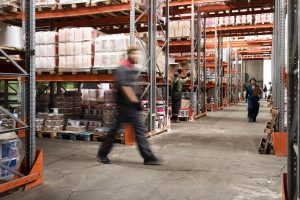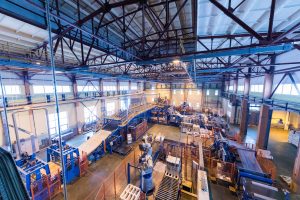The transformation of warehousing is vital for improving the efficiency, pace, and flexibility of the supply chain. The integration of automation through robots, automated guided cars (AGVs), and warehouse control structures (WMS) add this capability to drive improvements in the overall performance.
However, the actual challenge lies in seamlessly incorporating that technology into current warehouses. This is the approach known as retrofitting.
Retrofitting inside the context of warehouse automation entails installing systems and technologies within an existing warehouse structure and workflow. This can encompass implementing automated storage and retrieval systems (AS/RS) in older centers or integrating new software-led programs with legacy structures.
This article explores the diverse reasons that make retrofitting automation into a warehouse a complex endeavor, from infrastructure obstacles and workforce resistance to the intricacies of technology compatibility.
Why Retrofit Automation in Warehouses Today?
Reduced Human Error
A massive 62% of companies admit that human error in manual processes is the #1 root cause for inventory fulfillment issues. Automation reduces these errors that affect the accuracy and consistency of inventory management processes.
Faster Order Fulfillment
As the need for quick deliveries grows, time is of the essence. Automated systems improve order fulfillment time drastically leading to increased volume of orders processed for each warehouse.
Increased Productivity
Canary 7 research suggests that automation can increase overall productivity by 25%. Staff can not only perform a variety of tasks using that time to increase the efficiency output, but also save resources by letting manpower do some higher-value stuff alongside repetitive work. This will allow businesses to increase space usage by 20% and inventory use efficiency by at least 30%, bringing additional operational optimization.
Decreased Labor Costs
Amongst the highest costs in warehouse management, labor costs can cover up to 50%-70% of a department’s budget. Warehouses also have the opportunity to cut these costs by 30-40% in the next five years, using automation technologies. It allows businesses to spend less on manual labor and more funds can be invested in innovation/growth, so automation essentially becomes a cost-benefit investment.
Improved Working Conditions for All
The efficiency that automation adds to the equation is not just limited to profit margins; it also improves employee safety and welfare. For instance, warehouses that use automation technologies saw a 25% decline in workplace injuries.
What Are the Challenges of Retrofitting Automation?
Physical Constraints
Floor Preparation
Existing floors may have to be modified during retrofit, particularly if new equipment is heavier or has different operational requirements. For example, automation systems may require certain types of flooring materials or reinforcement to stand up to specific weights and movements in the machinery. And this preparation is not only labor intensive but it also comes with quite a bit of downtime.
Racking Modifications
Multiple industries may have racking systems that were not designed for automation applications. In some cases, racking systems need to be altered or replaced entirely—just so these can suit automated storage and retrieval systems. This modification has to be done in a way to ensure that the operation flow and security are maintained.
Civil Work
Some automation solutions need structural changes to accommodate them within the present facilities. This might include changing walls, doors, or even ceiling heights which could complicate how installation is to be performed. Changes of this nature usually require costly civil work, and those can strain project timelines and associated budgets further.
Space Constraints
Retrofitting automation structures like conveyors or automated guided vehicles (AGVs) often require extra ground space. Many existing warehouses are already running at near-complete ability, leaving little to no room to introduce a new automation era without predominant rearrangements or reducing storage area.
Infrastructure Limitations
Power Supply
Most existing warehouses and distribution centers were not built to handle the high-throughput automation systems. Retrofitting may even require extensive power supply changes to include upgraded circuits, transformers, and backups to keep the system running without interruption. This electrical work is expensive and slow, as it often requires hiring external contractors capable of safely working on the system.
Network Connectivity
Automation systems rely heavily on sophisticated data communication and network technologies, not something commonly available in aging facilities. This is achieved by upgrading to high-speed networks, establishing secure data connections, and facilitating communication between different automation components.
Operational Disruptions
Downtime
Throughout repairs, businesses may additionally observe greater downtime as equipment is mounted, tested out then tuned. This downtime can result in loss of revenue, and upended supply chains (if the facility is operating on a just-in-time model). At the same time, downtime can and will likely still happen at some points, however, the reality might be that downtime cannot be completely avoided.
Training
New automated systems necessitate significant training of the employees to accustom them to it. In addition to using their new technology, employees must be able to navigate changes in workflows and processes. This effort is time-consuming and, of course, less productive while employees acclimate.
Integration Challenges
Compatibility
Compatibility with current equipment is also a primary concern when considering new automation technologies. That may require reconciling different control systems, software applications, and types of machinery. Incompatibility can cause variability problems, increased maintenance costs, and worst of all—system failures.
Data Transfer
Automation heavily depends on how effectively different systems communicate with each other. On the other hand, retrofitting may mean building new data interfaces which can be difficult if current legacy systems were not engineered for it. Deriving the efficiencies relies on data transfer, but this in its own right can be a significant hurdle to surmount so that it is seamless and secure.
Conclusion
In conclusion, while retrofitting automation into warehouses provides vast demanding situations—from infrastructure boundaries to operational disruptions—the benefits go a long way to outweigh the problems in the long run. Automated systems reduce human mistakes, accelerate order success, reduce hard work charges, and decorate usual productivity. To remain competitive in today’s fast-paced retail environment, businesses must embrace automation with a forward-looking approach.
Looking for an answer that simplifies warehouse automation without the headaches? Carte+ is designed to tackle the unique challenges of retrofitting current facilities. It seamlessly integrates into city fulfillment centers with constrained areas, calls for no extensive ground training, and may be installed in weeks—no longer months. Unlike traditional systems, Carte+ operates successfully with fashionable racking and doesn’t require luxurious operator stations, permitting you to maximize your current infrastructure.
With Carte+, you can acquire faster order fulfillment, reduce operational charges, and decorate productivity—all while seeing a go-back on investment in under two years. Don’t allow automation-demanding situations to slow your commercial enterprise down. Contact us to learn how Carte+ can future-proof your fulfillment operations and keep you in advance in a swiftly evolving market.




